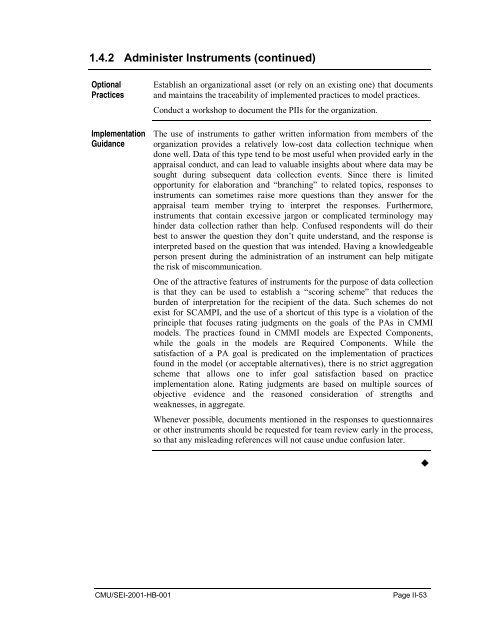Standard CMMI Appraisal Method for Process Improvement (SCAMPI)
Standard CMMI Appraisal Method for Process Improvement (SCAMPI)
Standard CMMI Appraisal Method for Process Improvement (SCAMPI)
You also want an ePaper? Increase the reach of your titles
YUMPU automatically turns print PDFs into web optimized ePapers that Google loves.
1.4.2 Administer Instruments (continued)<br />
Optional<br />
Practices<br />
Implementation<br />
Guidance<br />
Establish an organizational asset (or rely on an existing one) that documents<br />
and maintains the traceability of implemented practices to model practices.<br />
Conduct a workshop to document the PIIs <strong>for</strong> the organization.<br />
The use of instruments to gather written in<strong>for</strong>mation from members of the<br />
organization provides a relatively low-cost data collection technique when<br />
done well. Data of this type tend to be most useful when provided early in the<br />
appraisal conduct, and can lead to valuable insights about where data may be<br />
sought during subsequent data collection events. Since there is limited<br />
opportunity <strong>for</strong> elaboration and “branching” to related topics, responses to<br />
instruments can sometimes raise more questions than they answer <strong>for</strong> the<br />
appraisal team member trying to interpret the responses. Furthermore,<br />
instruments that contain excessive jargon or complicated terminology may<br />
hinder data collection rather than help. Confused respondents will do their<br />
best to answer the question they don’t quite understand, and the response is<br />
interpreted based on the question that was intended. Having a knowledgeable<br />
person present during the administration of an instrument can help mitigate<br />
the risk of miscommunication.<br />
One of the attractive features of instruments <strong>for</strong> the purpose of data collection<br />
is that they can be used to establish a “scoring scheme” that reduces the<br />
burden of interpretation <strong>for</strong> the recipient of the data. Such schemes do not<br />
exist <strong>for</strong> <strong>SCAMPI</strong>, and the use of a shortcut of this type is a violation of the<br />
principle that focuses rating judgments on the goals of the PAs in <strong>CMMI</strong><br />
models. The practices found in <strong>CMMI</strong> models are Expected Components,<br />
while the goals in the models are Required Components. While the<br />
satisfaction of a PA goal is predicated on the implementation of practices<br />
found in the model (or acceptable alternatives), there is no strict aggregation<br />
scheme that allows one to infer goal satisfaction based on practice<br />
implementation alone. Rating judgments are based on multiple sources of<br />
objective evidence and the reasoned consideration of strengths and<br />
weaknesses, in aggregate.<br />
Whenever possible, documents mentioned in the responses to questionnaires<br />
or other instruments should be requested <strong>for</strong> team review early in the process,<br />
so that any misleading references will not cause undue confusion later.<br />
<br />
CMU/SEI-2001-HB-001<br />
Page II-53
















